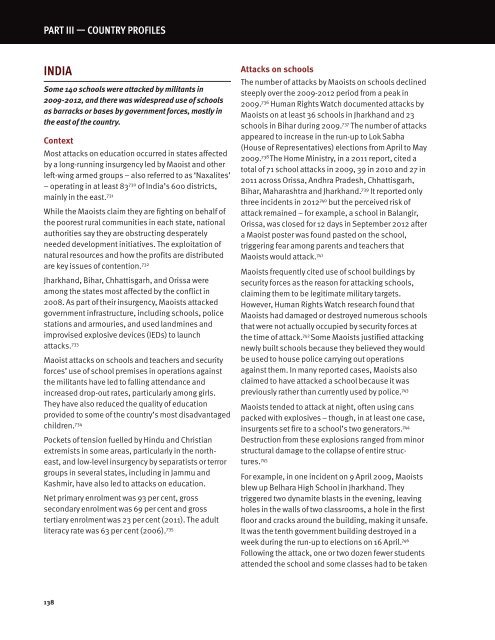You also want an ePaper? Increase the reach of your titles
YUMPU automatically turns print PDFs into web optimized ePapers that Google loves.
PART III — COUNTRY PROFILeS<br />
INDIA<br />
Some 140 schools were attacked by militants in<br />
2009-2012, and there was widespread use of schools<br />
as barracks or bases by government forces, mostly in<br />
the east of the country.<br />
Context<br />
Most attacks on education occurred in states affected<br />
by a long-running insurgency led by Maoist and other<br />
left-wing armed groups – also referred to as ‘Naxalites’<br />
– operating in at least 83 730 of India’s 600 districts,<br />
mainly in the east. 731<br />
While the Maoists claim they are fighting on behalf of<br />
the poorest rural communities in each state, national<br />
authorities say they are obstructing desperately<br />
needed development initiatives. The exploitation of<br />
natural resources and how the profits are distributed<br />
are key issues of contention. 732<br />
Jharkhand, Bihar, Chhattisgarh, and Orissa were<br />
among the states most affected by the conflict in<br />
2008. As part of their insurgency, Maoists attacked<br />
government infrastructure, including schools, police<br />
stations and armouries, and used landmines and<br />
improvised explosive devices (IEDs) to launch<br />
attacks. 733<br />
Maoist attacks on schools and teachers and security<br />
forces’ use of school premises in operations against<br />
the militants have led to falling attendance and<br />
increased drop-out rates, particularly among girls.<br />
They have also reduced the quality of education<br />
provided to some of the country’s most disadvantaged<br />
children. 734<br />
Pockets of tension fuelled by Hindu and Christian<br />
extremists in some areas, particularly in the northeast,<br />
and low-level insurgency by separatists or terror<br />
groups in several states, including in Jammu and<br />
Kashmir, have also led to attacks on education.<br />
Net primary enrolment was 93 per cent, gross<br />
secondary enrolment was 69 per cent and gross<br />
tertiary enrolment was 23 per cent (2011). The adult<br />
literacy rate was 63 per cent (2006). 735<br />
Attacks on schools<br />
The number of attacks by Maoists on schools declined<br />
steeply over the 2009-2012 period from a peak in<br />
2009. 736 Human Rights Watch documented attacks by<br />
Maoists on at least 36 schools in Jharkhand and 23<br />
schools in Bihar during 2009. 737 The number of attacks<br />
appeared to increase in the run-up to Lok Sabha<br />
(House of Representatives) elections from April to May<br />
2009. 738 The Home Ministry, in a 2011 report, cited a<br />
total of 71 school attacks in 2009, 39 in 2010 and 27 in<br />
2011 across Orissa, Andhra Pradesh, Chhattisgarh,<br />
Bihar, Maharashtra and Jharkhand. 739 It reported only<br />
three incidents in 2012 740 but the perceived risk of<br />
attack remained – for example, a school in Balangir,<br />
Orissa, was closed for 12 days in September 2012 after<br />
a Maoist poster was found pasted on the school,<br />
triggering fear among parents and teachers that<br />
Maoists would attack. 741<br />
Maoists frequently cited use of school buildings by<br />
security forces as the reason for attacking schools,<br />
claiming them to be legitimate military targets.<br />
However, Human Rights Watch research found that<br />
Maoists had damaged or destroyed numerous schools<br />
that were not actually occupied by security forces at<br />
the time of attack. 742 Some Maoists justified attacking<br />
newly built schools because they believed they would<br />
be used to house police carrying out operations<br />
against them. In many reported cases, Maoists also<br />
claimed to have attacked a school because it was<br />
previously rather than currently used by police. 743<br />
Maoists tended to attack at night, often using cans<br />
packed with explosives – though, in at least one case,<br />
insurgents set fire to a school’s two generators. 744<br />
Destruction from these explosions ranged from minor<br />
structural damage to the collapse of entire structures.<br />
745<br />
For example, in one incident on 9 April 2009, Maoists<br />
blew up Belhara High School in Jharkhand. They<br />
triggered two dynamite blasts in the evening, leaving<br />
holes in the walls of two classrooms, a hole in the first<br />
floor and cracks around the building, making it unsafe.<br />
It was the tenth government building destroyed in a<br />
week during the run-up to elections on 16 April. 746<br />
Following the attack, one or two dozen fewer students<br />
attended the school and some classes had to be taken<br />
138



